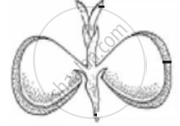Advertisements
Advertisements
प्रश्न
Describe the development of an endosperm in a viable seed. Why does endosperm development precedes embryo development?
उत्तर
The endosperm development is a result of triple fusion. During triple fusion, one of the male gametes fuses with the two polar nuclei of the central cell and give rise to primary endosperm cell (PEC). The primary endosperm cell divides repeatedly and forms a triploid endosperm tissue. The most common type of endosperm development is free-nuclear, in which the PEN undergoes successive nuclear divisions to give rise to a number of free nuclei. The endosperm thus formed is called free nuclear endosperm. Subsequently, cell formation occurs and the endosperm becomes cellular.
The endosperm thus developed is required to provide essential nutrients to the growing embryo. Therefore endosperm development occurs before the embryo development.
APPEARS IN
संबंधित प्रश्न
Angiosperms bearing unisexual flowers are said to be either monoecious or dioecious. Explain with the help of one example each.
Describe the development of endosperm after double fertilisation in an angiosperm.
Draw a labelled mature stage of a dicotyledonous embryo.
In which of the following the primary endosperm nucleus undergoes free nuclear division or karyokinesis?
Which of the following triggers an acrosomal reaction of the sperm?
In angiosperms, triple fusion is required for the formation of ______.
If an angiospermic male plant is diploid and female plant tetraploid, the ploidy level of endosperm will be ______.
Indentify the wrong statement regarding post-fertilisation development.
If an endosperm cell of an angiosperm contains 24 chromosomes, the number of chromosomes in each cell of the root will be ______.
Which of the following statements are true related to Seed X and Y?
 |
 |
| SEED X | SEED Y |
- Seed X is dicot and endospermic or albuminous.
- Seed X is dicot and non-endospermic or non-albuminous.
- Seed Y is a monocot and endospermic or albuminous.
- Seed Y is a monocot and non-endospermic or non-albuminous.
Choose the correct option with the respect to the nature of the seed.
